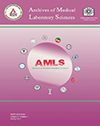Evaluation of allergy and eosinophilia level in peripheral blood of patients with cardiovascular diseases
Archives of Medical Laboratory Sciences,
Vol. 1 No. 1 (2015),
21 Ordibehesht 2015,
https://doi.org/10.22037/amls.v1i1.8962
Background: Cardiovascular diseases are the most common cause of deaths in Iran and other developing countries. The risk factors for cardiovascular diseases are divided into two categories; the variable risk factors and the non-variable risk factors. Many recent studies evaluated the relationship between higher eosinophilia and allergy levels with the incidence, progress and severity of cardiovascular diseases, but the exact correlation between these two still remains unknown. The current study was designed to assess the relationship between allergic responses and eosinophilia amongst patients with cardiovascular diseases in Ilam province, in comparison with healthy individuals.
Materials and Methods: In this case-control study, we enrolled 59 cardiovascular patients and 55 healthy individuals without any history of allergy and parasitic infections. A questionnaire including questions about demographic data, family history of heart disease, history of diabetes, hyperlipidemia, physical activity, smoking, stress, dietary fat consumption, salt intake, allergies to certain substances, history of parasitic disease and history of hypertension was completed. The blood was taken from each participant and CBC and IgE titer were measured.
Results: There was a significant relationship for the variables such as the family history of cardiovascular disease (P<0.001), diabetes (P<0.003), hyperlipidemia (P<0.0001), high blood pressure (P<0.0001) and physical activity (P<0.0001) between the case and the control groups. The mean IgE titer in case group was 95.3±71 and 62.44±49 in control group. The mean eosinophilia level in peripheral blood was 3.95±1.057 in case and 1.53±0.57 in control group. The difference between the IgE and eosinophilia levels in the case and the control groups was statistically significant (P<0.0001).
Conclusion: Based on our results, it can be concluded the increase in levels of IgE and eosinophilia can be considered by cardiologists as a reliable diagnostic tool for predicting cardiovascular diseases.
